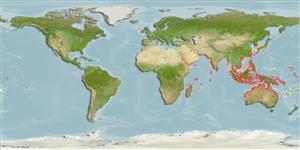Gastropoda |
Not assigned |
Amathinidae
Environment: milieu / climate zone / depth range / distribution range
Ecology
Host; depth range 20 - 30 m (Ref. 107327). Subtropical; 37°N - 31°S, 30°E - 147°W
Indo-Pacific and Mediterranean Sea. Tropical to subtropical.
Length at first maturity / Size / Weight / Age
Maturity: Lm ? range ? - ? cm
Found in subtidal areas, and under stones (Ref. 107328). Also found living on large bivalves, usually located close to the mantle edge, in the vicinity of the exhalant opening (Ref. 127091).
Life cycle and mating behavior
Maturity | Reproduction | Spawning | Eggs | Fecundity | Larvae
Members of the order Heterostropha are mostly simultaneous hermaphrodites (Ref. 833). Ovitestis contains ripe sperm and ova. Genital system is hermaphroditic throughout (Ref. 127091).
Templado, J. and R. Villanueva 2010 Checklist of Phylum Mollusca. pp. 148-198 In Coll, M., et al., 2010. The biodiversity of the Mediterranean Sea: estimates, patterns, and threats. PLoS ONE 5(8):36pp. (Ref. 85339)
IUCN Red List Status
(Ref. 130435: Version 2025-1)
CITES status (Ref. 108899)
Not Evaluated
Not Evaluated
Threat to humans
Harmless
Human uses
| FishSource |
Tools
More information
Trophic EcologyFood items (preys)
Diet composition
Food consumption
Predators
Population dynamicsGrowth
Max. ages / sizes
Length-weight rel.
Length-length rel.
Length-frequencies
Mass conversion
Abundance
Life cycleReproductionMaturityFecunditySpawningEggsEgg developmentLarvae PhysiologyOxygen consumption
Human RelatedStamps, coins, misc.
Internet sources
Estimates based on models
Preferred temperature
(Ref.
115969): 21.6 - 28.7, mean 28.1 (based on 103 cells).
